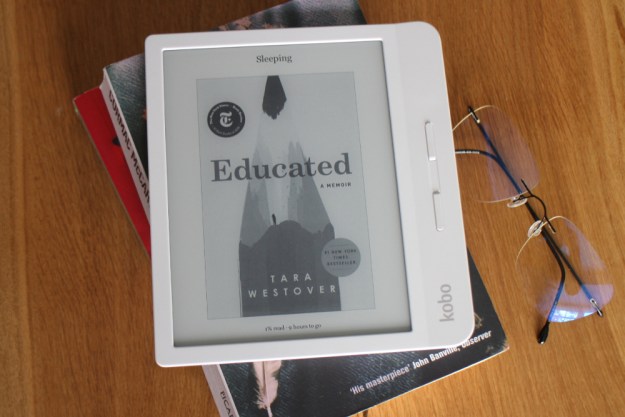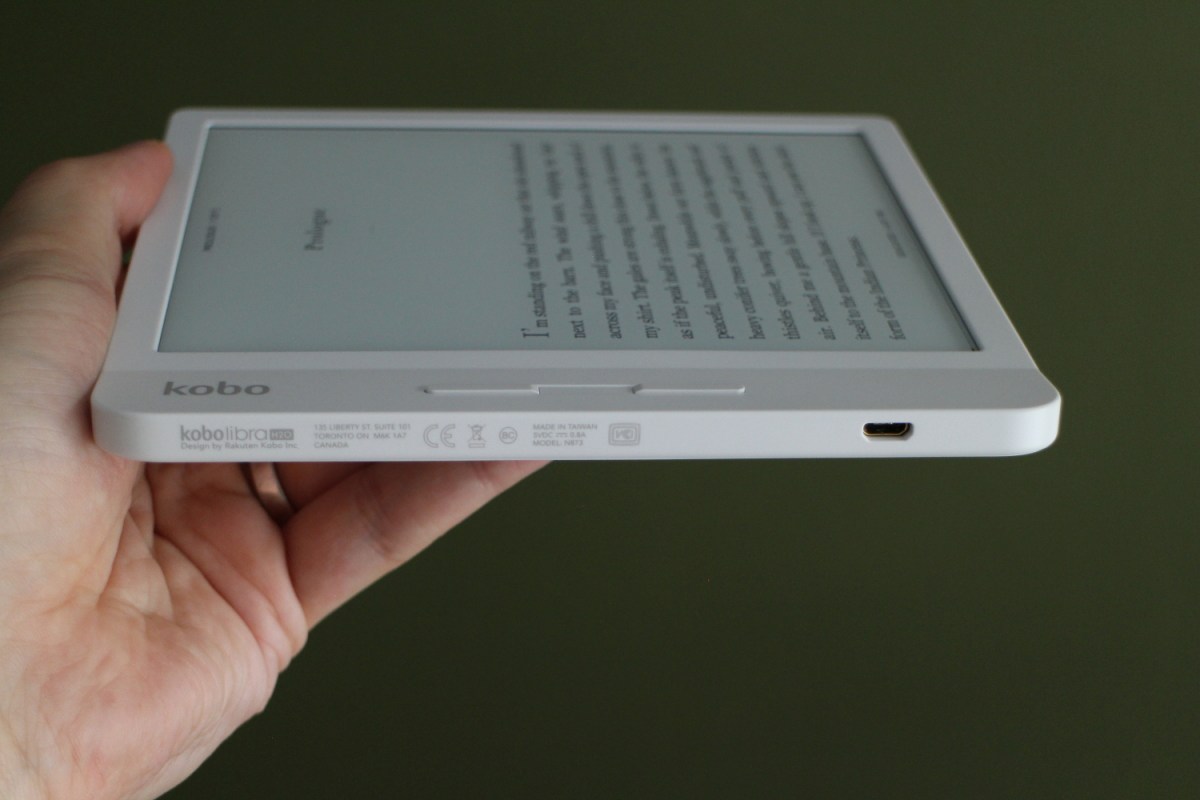
- Bright and legible screen
- Comfortable to hold
- Automatic adjustments filter out blue light at night
- IPX8 water resistance
- Chunky, plastic body
- Micro USB port for charging
The Kobo Libra H20 bundles together some of the best developments in ebook readers from the last few years. We have a sharp, 7-inch touch screen, an automatically adjusting backlight, water resistance, and page turn buttons packed into a lightweight form that’s going to be familiar to fans of the Kindle Oasis or the Kobo Forma.
What – you may wonder – makes the Libra H20 worth considering when these two excellent options already exist? At $170, the Kobo Libra H20 is $100 cheaper than the Forma and $80 cheaper than the Oasis. The question is whether Kobo had to cut too many corners to get that price down.
A winning design done cheaper
Just like the Forma before it, the Kobo Libra H20 owes a design debt to the Kindle Oasis, Amazon’s high-end ebook reader. The Forma offers a larger 8-inch screen, but the Libra H20 sticks with 7 inches and is almost precisely the same size as the Oasis. It’s a good size, though a tad too large to slip into most pockets. It weighs 192 grams, just a hair heavier than Amazon’s device, but it boasts the same IPX8 certification, which means it can survive for up to an hour in two meters of water without sustaining damage.
The screen has a 1,680 x 1,264 resolution, which translates to 300 pixels-per-inch; that’s exactly the same as the Oasis and it’s plenty sharp for comfortable reading.

There are some clear differences between the Libra H20 and the Kindle Oasis, though. The Libra H20 is finished in black or white plastic, it’s much thicker, the screen is recessed, and the page turn buttons sit on an angled spine that accentuates the feeling that you’re holding a book. The back is flat with a textured plastic finish that enhances grip slightly. There’s a sunken power button on the back, presumably recessed to ensure no accidental presses, and the Micro USB port for charging is on that angled spine.
You can turn the Kobo Libra H20 either way up, gripping the spine in your right or left hand, and it will automatically flip the text the right way. You can tap the screen to turn pages, but the dedicated turn buttons are much better, and you can customize which moves forward or back. I got sucked into Educated for several hours and was never distracted by the weight or operation of the device.
It’s a good size, though it’s a little too large to slip into most pockets.
It does look and feel cheaper than the Kobo Forma and it doesn’t come close to the high-quality feel of Amazon’s aluminum chassis in the Oasis. But if you plan to buy a cover — Kobo offers four SleepCover options in black, grey, rose, and aqua – then you may not care about the external appearance; it’s what’s inside that counts.
Automatic light adjusts for comfort
The E Ink screen in the Kobo Libra H20 is legible in direct sunlight or in a dark room. You can slide your finger up and down the left side of the screen to adjust the brightness, but it’s often quicker to just open the top menu. It would be nice if the backlight adjusted automatically to match the lighting in your environment, but it lacks an ambient light sensor.
It does still change the brightness without your input as well as the warmth of the screen to remove blue light near bedtime so you get to sleep a bit easier, but the automatic adjustments are based on the time zone you set and the bedtime you pick. You may want to tweak the level of warmth as it will grow more and more orange the later you read.

While the quality of the Kobo Libra H20’s screen is high — and I found it comfortable to read on for hours at a time in different lighting conditions — I did notice some differences between it and the Oasis I switched from. The automatic brightness feature with the Oasis is excellent, and generally nails the level required whether you’re outside or in a dark room. That automatic change also helps to maximize battery life. I often had to jump into the settings with the Kobo and adjust the brightness manually, but it’s easy to forget you have the brightness cranked up.
It’s not a major problem, since it’s easy to tweak, but the brightness adjustment controls also don’t offer the same segmented level of fine-tuning as the Oasis, so it can be tricky to get the precise level you want. It’s worth remembering that many ebook readers don’t offer automatic adjustments.
Performance and interface
Even the best ebook readers tend to have basic hardware inside and the Kobo Libra H20 is no exception. Pages turn almost immediately when you press the button, but there’s a fairly lengthy pause when you turn the Libra H20 on after it has been turned off. I didn’t have any issues with ghosting in my time testing it.
Kobo has overhauled its interface to improve navigation.
The Kobo Libra H20 comes with 8GB of storage, which gives you space for around 6,000 books. There’s a comprehensive choice of more than six million in Kobo’s store, but prices tend to be a little higher than they are on Amazon. One nice thing worth noting is that the Kobo Libra H20 supports the EPUB format out of the box, whereas you have to jump through some hoops to read EPUB books on your Kindle.
The software on the Kobo is good for reading and you can adjust fonts, tap and hold on the text to search for unfamiliar words, and all sorts of other basic things you’d expect to find. It’s not so great for searching for something to read, but that’s true of all ebook readers. I prefer to search for and line up books on my desktop and then send them over.

Kobo has overhauled its interface to improve navigation, so there’s a bar at the bottom when you read that shows your overall progress through the tome. You can also swipe up from the bottom and tap on the timeline to add bookmarks or slide forward and back through the book with preview pages popping up as you skim through. There’s an annotation tool in here as well. I didn’t find much need for this reading a novel, but if you use your ebook reader to study it will surely be a welcome addition. These interface updates aren’t unique to the Libra, though, as they’ll be rolling out on other Kobo devices, too.
Extra features
The Kobo Libra H20 offers a couple of built-in features that I really like. Firstly, there’s the ability to save articles online and then read them later with Pocket, which is a very usable cross-platform service that allows you to save articles on your phone or laptop and read them on your Kobo Libra H20.
Kobo also offers Overdrive integration, which enables you to sign up with your local library and check out digital titles in several countries including the U.S., the U.K., Canada, Australia, New Zealand, Hong Kong, Denmark, Finland, Norway, Sweden, and Taiwan.
You can get equivalents to both on a Kindle, but it involves jumping through more hoops. Borrowing digital books from public libraries is also sadly limited to the U.S. with Amazon’s devices.
Battery and charging

There’s a 1,200mAh battery in the Kobo Libra H20 and you can expect it to last for several weeks between charging, assuming you’re reading for half an hour a day. I’ve been using it for a week now, reading for several hours on a couple of occasions, and I’ve barely put a dent in the battery level.
Charging is via the Micro USB port. I much prefer USB-C, simply because it’s always the right way up when you plug in, and because most Android smartphones and even laptops charge via USB-C, so having one cable to charge all your devices makes life more convenient. It’s not the biggest deal, though, as people still have Micro USB cables and even Amazon’s refreshed Oasis still has a Micro USB port.
Price, availability, and warranty information
The Kobo Libra H20 costs $170. Pre-orders start on September 10 and it will be in stores from September 17.
Kobo offers a standard limited warranty that covers manufacturer defects for one year from the date of purchase.
Our Take
The Kobo Libra H20 emulates the top ebook readers, but at $170 it’s considerably more affordable. Kobo has compromised on design, with a chunky plastic body, but headline features — like the sharp screen with the adjustable brightness and warmth, the water resistance, and the long battery life — are all intact.
Is there a better alternative?
The only ebook reader I prefer is the Kindle Oasis, which has a much nicer design and a more refined feel in general. It also has support for audiobooks, something that’s entirely absent from the Kobo Libra H20, but it is a lot more expensive, starting from $250.
The larger screen is the only reason I can see that you might be tempted to opt for the Kobo Forma, but it’s not enough to justify laying out an extra $100. If money is a concern, then the Kindle Paperwhite ticks most of the same boxes and comes in at $130, but you lose the page turn buttons and the blue light filter.
Take a look at our best ebook readers guide for more options.
How long will it last?
Provided you take proper care of it, the Kobo Libra H20 should last you a few years, perhaps even five, before it needs to be replaced. But a cover or case of some sort is definitely a good idea.
Should you buy it?
Yes. If you’ve been eyeing the Kindle Oasis or the Kobo Forma longingly, but you haven’t bitten because of the high price, then the Kobo Libra H20 could be exactly what you’ve been waiting for.



